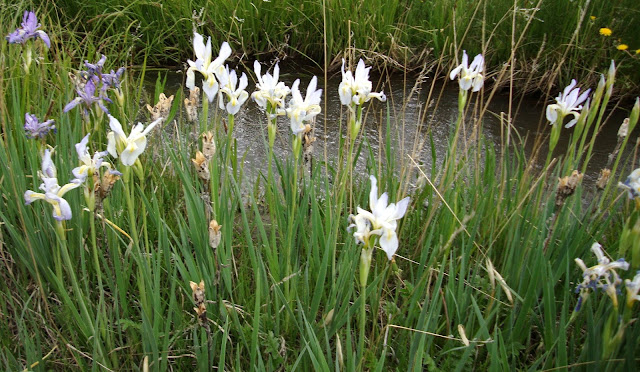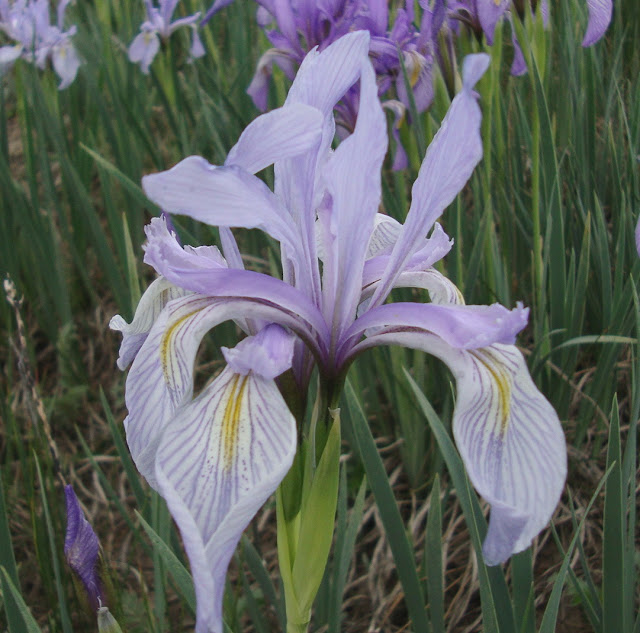Horticultural and botanical musings from the Rockies, Great Plains and beyond. In humble tribute to Goddess Flora.
Wednesday, December 30, 2015
Steel houseleeks
They look more like artichokes than cousins to houseleeks, although they're actually just sedums according to most botanists!
I first grew Orostachys spinosa (I'm not ready to call them Sedum--it apparently is genetically very close to others in that amalgam) when I first came to Denver Botanic Gardens in 1980. The propagator had grown several wonderful specimens from seed, and I remember planting these in what I supposed was a perfect spot in the Rock Alpine Garden. I can't recall if they died that winter or the following summer, but they didn't last very long at all. This happened again and again to me--and I assumed that this seemingly tough plant that supposedly grew in Tangutia where it gets to -60F in the winter--could find Denver too harsh--well, this didn't seem likely. Why couldn't I grow it?
Here it is growing exactly as it shouldn't be, on an open slope. And blooming no less!
Finding it in the wild was no good at all: it grew absolutely everywhere in the Altai mountains of Kazakhstan from the lowest foothills and open steppe to above treeline. It would carpet the ground.
More ground carpets! It got to be a joke every time we got out of the jeep: who will see the first Orostachys? Didn't take long for one or another of us to cry out "here they are AGAIN!". I can't imagine how many billion plants must be growing there...
The form rom the altai is a tad greener, and somehow plumper leaved than the steely blue form we grew already. One of the charms of Orostachys, however, is that they look different in almost every season!
I began to notice that the "open ground" they seemed to favor was usually very shallow ground indeed, and they grew with special vigor on and near outcrops...
We eventually found some in bloom, but most were just spindling up to bloom...
Often on rocks they develop interesting tints on the leaves..this gives a hint of how we finally learned to grow them well in gardens...
Aha! After a week or so we were late enough to catch them in bloom--not spectacular, perhaps, but very winsome!
In slightly shaded, moister spots they turn more green...
Darker tins in crevices and drier spots they are usually darker and more colorful.
I would have liked to have a few rosettes from every colony to compare--look how much greener this one is...
I love them growing with lichened rocks...
They even seem to grow on open soil in the wild: don't try this in your garden, however!
And finallywe find a grand old spexcimen in BLOOM: on solid rock
Masses of them growing in the fabulous hardy succulent nursery in Bavaria: good silver form.
And the enchanting red one--in the hands of Hans Graf. He's given it to me twice and I've killed it both times...
I end with a trough that shows how they seem to be happiest in s shalllow container. The entire genus seems to have one more beautiful, useful plant after another. But none which I prefer to these rolly poly mounds of silver beauty.
The very first image in this blog is a trough done by Sandy Snyder, who taught me that these like the shallower root run. This trough was so successful that the image has been "borrowed" by many websites. I even found business cards with the image: I keep trying to recreate it (this one is no longer at my house--enough said!)..
Tuesday, December 29, 2015
Wild iris
I'm sure you're asked to "What's your favorite flower"--and for those of us who make a living pushing petals, this is a silly question. We love them all! Or as my buddy Randy Ortega says (of Nick's Nursery in Aurora) "my favorite flower is the one that just went out the door". Except in my case, the one that's looking at me now. But I confess, there are a few that haunt me just a tad more than others--and most any wild iris (which for those of us in most of the interior West means Iris missouriensis) rates right up there. How many Junes as a child did we drive past the meadows around Fraser and Kremmling in June when they were an azure dream of color and I wanted so to stop to go out and wander among them...but these were fishing trips: the likelihood my dad would stop was nil (he was so anxious to get to Oak Creek and see his brother)...
But eventually I did stop. Again and again. These pictures are from one especially memorable stop five and a half years ago exactly (June 28, 2010) on a memorable drive through South Park (not the one on T.V.) with Wiert Nieuman --who'd just retired as director of the Garden at Utrecht, Netherlands (he'd spoken at our N.A.R.G.S. conference in Salida earlier that week). I've never seen anyone scamper into a field of flowers as quickly as he did that day!
Of course, one makes a bee-line for the albino.
This one is mostly fetching for the hint of blue in it.
But it's really the blues (or lavender blues--or azure--whatever shade you may wish to call it) that deliver the goods...
Really, they speak for themselves. And I shall let the rest do so.
Wiert Nieuman in a field of wild iris!
Thursday, December 24, 2015
Delimited International Airport
I fly quite a bit and coming in and out of Denver--I am always struck at how incredibly monochromatic and (shall we say) minimalistic the bare acreage is coming home. It's such that I must intersperse my depression-era pictures with some more colorful images to cheer them up a tad...the bigger shots were all taken on a single drive--albeit in winter. Spring, summer and fall are about the same, alas.
 |
| That's the drive to the Airport through Asiatic Istanbul..roadside annual plantings... |
A slight contrast to the following...
 |
| There are a few clouds in the distance in this one at least...sort of. |
 |
| Here's what the Minoans were doing four thousand years ago in their homes..a thrill to find this from Santorini at the Athens Archeological museum last summer. |
 |
| It would be tricky to plant that slope... |
 |
| A thousand year old fresco at Hosios Loukas, near Delphi... |
 |
| The rental van enlivens this one a tad. |
 |
| Another palette cleanser... |
 |
| Good thing we have decorative lenticular clouds... |
 |
| Never realized subways could be so clean and decorative--Athens last summer... |
 |
| Aaah. More clouds. |
 |
| Graffiti can liven things up... |
 |
| The bus pane is a distraction.... |
 |
| Modern art can also be grey--albeit somewhat decorative. |
 |
| A car! |
 |
| There are prairies nearby this colorful (although this was taken last July near Troy) |
 |
| The grass cover above is pretty thick. |
 |
| A bit much to dream of Antelope Valley, California recreated. |
 |
| I don't think the gulleys are intended--but they do draw the eye. |
 |
| It would be nice to have some color: Antelope Valley again a decade ago |
 |
| A wedge of weeds mostly |
 |
| California poppies are facultative perennials in Colorado: but this California |
 |
| That same cloud again... |
 |
| Skipped to South Africa for this program break... |
 |
| More of less |
It is stark as the West and Midwest can often be. Unrelentingly so. It's a bit of an embarrassment that there was 6 billion dollars for engineering and a good deal less (if any?) for revegetation. Let's not even talk beautification. As a horticulturist, this is about as close to a slap in the face as one can get.
Subscribe to:
Posts (Atom)
Featured Post
A garden near lake Tekapo
The crevice garden of Michael Midgley Just a few years old, this crevice garden was designed and built by Michael Midgley, a delightful ...








































